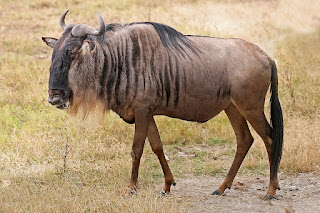
The wildebeest is a mammal that belongs to the antelope family. Wildebeest live in the central, eastern and southern parts of Africa. They prefer life in green plains and open forests. Wildebeest is also known as gnu. These strange looking animals have high reproductive rates despite being prey for a number of predator. Their numbers remain high and stable in the wild. Wildebeest are not on the list of endangered animals.
They are the most abundant big-game species in the East African Savanna.
Wildebeest is one of the largest antelopes. It can reach 8 feet in length, 4.5 feet in height and weight up to 600 pounds.
The Dutch, who settled in South Africa, gave the animal its name, Wildebeest, which means wild beast.
Wildebeest looks like a close relative of a bovine because of its disproportional body. It has large, box-shaped head, and strongly built front part of the body. Hindquarters are slender, just like in other antelopes.
Wildebeests stick together in a herd to protect themselves from wild predators. They are most vulnerable to predation when they are separated or alone.
Wildebeest has a mane just like horse. Both males and females have curved horns.
They are territorial and males will challenge one another when they feel like their territories are overlapping.
Wildebeest is a grazer. It eats mainly short grass. Wildebeest needs to drink water at least every other day.
Blue Wildebeest got name as their coat has a blue sheen.
Due to harsh climate in Africa, wildebeest is well known for its seasonal migration. They will move toward the west when sources of food and water become scarce.
There are around 1.5 million Blue Wildebeest living in the Serengeti alone!
During migration, wildebeests travel between 500 and 1000 miles. Timing of migration is determined by weather conditions, but it usually takes place during the May and June.
They can run up to 40 mph.
Migrations are one of the most fascinating phenomena that can be seen in Africa. Migratory group consists of 1.5 millions of wildebeest and hundreds of thousands associated animals, such as zebras and Thompson’s gazelles.
Bulls have a wide array of loud vocalizations, from moans to explosive snorts.
Wildebeest live in large herds, composed of animals of both sex and their offspring. Life in herd provides protection against predators.
About 80 percent of the females calve within the same two- to three-week period, creating a glut for predators and enabling more calves to survive the crucial first few weeks.
Main predators of wildebeest are lions, hyenas, cheetahs and African wild dogs.
These large mammals are continually on the move, as they seek favorable supplies of grass and water.
During mating season, breeding groups composed of around 150 animals will be created. These groups are further divided in several smaller groups, where the most dominant male performs different kind of antics to impress the females.
There are two species of wildebeest, the black wildebeest, and the far more common blue wildebeest.
Male wildebeest are also known as “clowns of savanna” because of the weird behavior during mating season.
The blue wildebeest has a silvery blue hue to the coat, with black mane and tail.
Males also attract females by rubbing a scent (produced in the preorbital and interdigital gland) into the ground. They will urinate and defecate to mark their breeding territory and to keep other males away.
The black wildebeest is actually primarily brown in color, with a flaxen colored tail and a stiff upright mane of black and pale tan.
Pregnancy lasts 8.5 months and it ends with a single baby. Female gives birth in the middle of the herd. 80% of calves are born during the same 2-3 week period, just before rainy season.
Black wildebeest weigh between 250 and 400 pounds and 44 to 48 inches at the shoulder, while the blue wildebeest averages 300 to 600 pounds and stands 4 to nearly 5 feet at the shoulder.
Calves (babies) are able to walk as soon as they are born. Few days after birth, babies can run with the rest of the herd. Calves will suckle during the first four months of their life. Milk-based diet will be enriched with grass 10 days after birth.
A mature male blue wildebeest may have horns over 60 inches wide.
Wildebeest can live up to 20 years in wild.










Your post is a breath of fresh air compared to all the shallow and clickbaity content out there. It’s clear that you put a lot of thought and effort into researching and writing this piece, and it shows in the depth of insights and analysis you offer. I’m impressed by your expertise on [specific topic] and I’m looking forward to reading more of your work in the future!